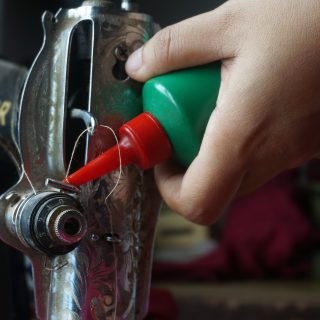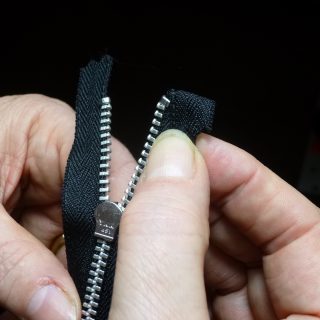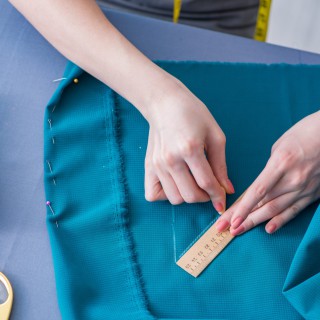You might be excited now thinking finally somebody’s going to guide you through how to sew the mouths of mansplainers shut, but unfortunately that’s not happening. Instead, I am going to focus on how to sew the holes and rips on your and your family’s t-shirts, pants, and jeans.
Learning how to repair those is crucial, because you probably have a favorite t-shirt or pair of pants, and if an accident happens to something from your wardrobe, a secret article in the cosmic lawbook dictates that it should happen to your favorite piece of clothing. If you are not one of those who think: “Oh, okay, ripped stuff, that was once fashionable too,” you’ll be able to save your favorite ripped t-shirts and pants by learning the basics of repair.
Moreover, even if the hole is not on your favorite but on just a regular, dull, or mediocre piece of clothing, sewing the hole will still be more economical and less exhausting than going to a shop and trying to replace it with another mediocre product.
Now, let’s see in detail how you should go about sewing a hole.
How to Sew a Hole
Identifying the Type of the Hole
We can follow the steps with a hypothetical case: let’s say that your husband (he can be either hypothetical or real – that doesn’t really matter) was dilly-dallying in the garage with tools that gives him a manly look in his skewed view of things, yet, being the slouching good-for-nothing that he is, he ended up ripping his jeans because it got caught by a tool he doesn’t know the purpose of, and being the good-for-nothing crybaby that he is, immediately ran to you in panic: “Darling, there is a rip on my jeans, what do I do? Shall I run to the shop and get a new one?”
You don’t even need to turn and look at him because seeing that this is the person you ended up marrying might be a bit harrowing at that moment (but what are you going to do – it’s the species), and because you are a mature human being with considerable talent and practicality at your disposal, you say: “Bring it over and let me have a look”.
Of course, during your look, he’s hovering above your head like a restless mayfly, but you are pretty used to that by now. So, you can easily identify the type of the hole:
- Seam hole – whether the murderous tool that attacked your husband damaged only the seams by undoing the seam stitches.
- Clean hole – whether the murderous tool just made an opening but didn’t take any fabric along with it.
- Open hole – whether the murderous tool also brought a piece of fabric so that you wouldn’t only need to stitch, but also to patch.
How to go about sewing a hole depends on the type of the hole – in other words, it depends on how proficient your husband was in his maladroitness.
How to Sew a Seam Hole
If the opening made by the murderous tool that viciously attacked your husband is just on the seam, then you are lucky because that is the easiest hole to mend. You just need to turn the garment inside out and start stitching.
For sewing machines: If you are going to use a machine for sewing the hole, you should apply simple straight stitching on the edges of the hole with a thread that’s preferably the same color as the fabric. To make sure that your mending is strong, you might need to go over the stitch a couple of times.
For hand-stitching: If you are going to repair the hole with hand-stitching, you should apply a simple running stitch. Just fasten the thread to the needle and start stitching on the edges of the hole by going up and down. If you want the stitch to be solid, make sure there’s not much of a gap between the stitches.
Depending on the type of fabric, the strength of your repair might also change. For example, sewing a hole in jeans might require more overlapping stitches. All in all, though, it’s a very straightforward sewing process, and the end-result might even be sturdier than the seam stitches that the garment originally featured.
How to Sew a Clean Hole
In a clean hole, there might be all kinds of rips: a straight rip, an L-shaped rip, a zigzagging rip, a freestyle rip – depending on how the murderous tool decided to punish your husband’s staggeringly stubborn clumsiness, but at least the fabric is still there, so you don’t need to find a matching fabric to patch the opening. They are also very easy to repair and take only a bit more work than stitching a ripped seam.
Before starting the sewing process, there are a couple of things you should do:
- Bind the torn pieces back together with a thread or fabric underneath, so there’s something holding them together to reduce further damage and ease sewing. Using a same-color fabric underneath as an interface is a good idea, because you might keep it there while stitching, and it will reinforce the repair.
- Iron the piece of clothing to make it flat.
- Cut off threads that loosened as a result of the rip, so they don’t become a nuisance afterwards.
For sewing machines: If you are going to keep the interfacing fabric at the back, you can do either straight stitching or zigzags. With straight stitch, you’ll be stitching through the interface at the back and the interface itself will be doing the job of keeping the torn parts together. If you opt for a zigzagging stitch, though, you won’t be just stitching the interface but also the torn parts together, and it will be far sturdier. You can also do zigzags without an interface, but as long as you have a spare piece of fabric, there shouldn’t be anything holding you back from using it as an interface.
For hand-stitching: For hand-stitching, I absolutely recommend keeping the interface underneath the torn part, because we are all lazy and no matter how skilled and thorough we are, neither the appearance nor the frequency of our hand stitches will satisfy us. Still, I will tell you how to make the most of it: start by threading the needle from underneath the interface, move to the other side of the rip and make as tiny a vertical stitch as possible, and make sure all the following vertical stitches are as tiny as possible, too. The tinier they are, the sturdier and better-looking the repair will be.
How to Sew an Open Hole
Now, let’s talk about the most difficult hole of them all: an open hole that’s in need of not only good stitching, but also masterful patchwork.
Before getting onto the act of sewing itself, there are a couple of things you should be doing with an open hole:
- Cut off the loose threads, so you have a tidy opening to work on and a clear idea of what to do.
- Find a patch. Of course, most prefer picking one that matches the color of the original fabric, but I personally am against that idea. No matter how good you stitch, it’ll be clear that you did some patchwork, and when you pick a same-color patch, the fact that it is a patch becomes somehow more emphasized in the eyes of the observers. However, if you try to be more brave and pick a different yet matching color, or go downright creative and pick a fabric with some Pink Floyd album art printed on it as your patch, there is a slight chance that your sense of fashion and mediocre taste in music will be the focus of observation and not the fact that your garment needed a patch or what an imbecile your husband is.
- Cut the patch fittingly to the opening, but not fittingly in an absolute manner. It should be at least an inch longer on each edge so that you have something to stitch to. After cutting the patch, secure it underneath the opening with pins.
Now, we can start stitching.
For sewing machines: You should use a zigzag stitch to achieve sturdiness in the end-product. Once you are finished with the stitch, you can press or iron it to reinforce and flatten it.
For hand-stitching: Similar to the process for clean holes, you should leave as little gaps in-between stitches as possible. Other than that, you can use any technique you like as long as you are doing the stitch work on the patch. Apply a good press with your ironing machine after you finish stitching and you are done!
Congratulations! The garment that has been damaged during a vicious attack on your husband by a ravenous tool is as good as new now! Your husband? Nothing ever changed for him!
Final Thoughts
Accidents suffered by your wardrobe might happen anytime: during a peaceful hike, a cheerful BBQ party, a masked ball where you don’t know what the heck you’re doing, or a sensational neighborhood fight (and no one has an idea of how it escalated). However, once you get the hang of how to mend rips and holes on your t-shirts, jeans, or pants, you don’t need to worry about that anymore. You can easily mend your torn jeans with a needle and thread and get back to fighting before people are bored or the law enforcement arrives.
Sewing a hole, whether a clean or an open one, is easy, economical, and less arduous than going to a shop, looking at all the mediocre choices, and despairing – especially when there is a heated neighborhood fight going on. Therefore, make the best of your skills and tools.






